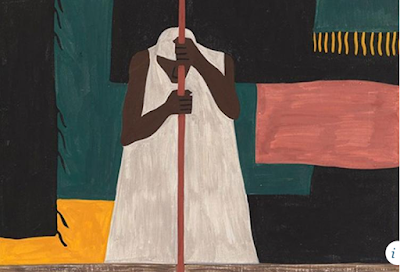Tues, June 1 to Friday, June 3 The Great Migration Series
VERY, VERY IMPORTANT INFORMATION!
All GRADES FOR THE 4th QUARTER CLOSE ON FRIDAY,
JUNE 11 AT MIDNIGHT!
NOTHING WILL BE ACCEPTED AFTER THAT TIME.
Tonight's Long Way Down book circle link: https://rcsdk12.zoom.us/j/98816351042?pwd=eTVSR25QV1dra1ZFUmJscHRtZ3dNZz09
"Most of my work depicts events from the many Harlems that exist throughout the United States. This is my genre. My surroundings. The people I know . . . the happiness, tragedies, and the sorrows of mankind . . . I am part of the Black community, so I am the Black community speaking." Jacob Lawrence
1) Back Ground Reading / content questionsvocabulary:
1.to chronicle (verb)- to record in a factual and detailed way
2. impoverished (adjective)-made poor OR deprived of strength and vitality
3. dynamism- (noun)-the quality of being characterized by vigorous activity and progress.
4. vignette (noun)-a brief evocative description, account, or episode.
Jacob Lawrence: Painter of Black History and Life
1) Though he came of age before the Civil Rights Movement brought African Americans the rights they had long been denied, Jacob Lawrence (American, 1917–2000) forged a prominent career as an artist, chronicling the story of black life in America through his paintings. Born in New Jersey and raised from the age of thirteen in Harlem, New York City, this Northeast native had southern roots. He was the child of migrants who moved, together with millions of other African Americans, from the impoverished rural South to urban, industrialized Midwestern and Northeastern cities during the mass relocation known as the Great Migration (1915–1950s). Lawrence maintained that he was “a child of the Great Migration,” which shaped the course of his own and his fellow African Americans’ lives.
2) If the Great Migration provided him with geographical advantages, it was Harlem, then in the midst of the cultural and intellectual outpouring known as the Harlem Renaissance (1920s–1930s), that inspired him to make art. As he once described his beloved neighborhood: “All these people on the street, various colors, so much pattern, so much movement, so much color, so much vitality, so much energy.” The textures of Harlem, and the narrative dynamism of the songs, Bible stories, sermons, and tales of his neighbors’ journeys north that he witnessed in church, shaped Lawrence’s approach to art making. He realized that through painting he, too, could give voice to the experiences of his people.
3)In 1934, he enrolled in his first art classes. By the time he was twenty-three, he had completed five narrative series on major people and events in black history, including Toussaint L’Ouverture (the leader of the Haitian Revolution), Harriet Tubman (the former slave and abolitionist who smuggled others to freedom on the Underground Railroad), and the Great Migration itself. He used descriptive titles; vibrant patterns and blocks of color; and simplified, angular figures and forms to distill epic narratives into powerfully direct images. This style, applied to topics ranging from neighborhood life to the experiences of black industrial laborers to the Civil Rights Movement, characterized his work throughout his career.
4) Through his vivid, accessible visual storytelling, Lawrence presented the richness and complexities of African American history and culture to his own community—and beyond. In 1941, with segregation in full force, he broke a racial barrier by becoming the first African American artist whose work was acquired by The Museum of Modern Art.
“A Child of the Great Migration” Tells the Tale
5)Between 1940 and 1941, while World War II raged and Harlem continued absorbing newly arriving black southerners, a young Jacob Lawrence was busy studying, listening, and painting. He was working on one of the five narrative series through which he chronicled the heroes, heroines, and watershed events of African American history, this one focused on the Great Migration. Before putting brush to panel, he spent months at the library, researching this mass relocation. He also listened to his parents, family, and neighbors tell the tales of their own northward journeys. And he wrote, completing the text for the short narratives that would serve as both titles and explanations for the sixty individual paintings that together comprise his celebrated Migration Series (1940–41).
6). “I worked very fast,” Lawrence once explained about his process. “From the concept and the drawings to the completion of the works … that may have taken six to eight months …” Needing materials that were both inexpensive and suited to his working method, he used quick-drying tempera paint and hardboard panels. Spreading out all of the panels simultaneously, he sketched images and scenes with a pencil. He then filled in his sketches with a limited range of colors, working with only one color at a time and applying it across all sixty panels. In his words: “I had a very simple palette. I went through all the panels painting yellows, greens, blues, so they’re all the same. I didn’t mix color. I left it pure, as it was, ’cause I wanted the series to be a unit. I consider it one work, not 60 works.”
7) Lawrence focused on the people at the heart of the Great Migration, breaking apart this mass relocation of millions into intimate vignettes, often centered upon human figures. Each one is spare, in keeping with the artist’s belief that a lot of information could be conveyed through limited visual means. In the panel titled In the North the Negro had better educational facilities, for example, three young girls stand side-by-side facing a chalkboard, their right arms outstretched as they practice writing numbers. The scene is composed of geometric shapes, with rectangles forming the gray chalkboard and the brown walls of the classroom, triangles forming the girls’ braids, and a combination of these shapes forming their pastel-colored dresses. Like these girls, Lawrence benefitted from the better education made possible by his elders’ migration north. Through it, he educated others—black and white—when he embarked upon the making of Migration Series as both an artist and a teacher.
Assignment 1: Please respond to the following biographical questions about Jacob Lawrence, weaving in text from the above information. Complete sentences!
1. What was Jacob Lawrence best known for chronicling?
2. What medium did Lawrence use to record the African American experience?
3. In what way was the Harlem Renaissance an inspiration for Lawrence?
4. What are the techniques employed by Lawrence in his narrative series?
5. How did Lawrence prepare himself prior to creating his paintings?
6. With "segregation in full force", how did Lawrence break the racial barrier?
7. When was the "Great Migration" series completed?
8. Why did Lawrence use a "spare" technique?
*************************************************
Thursday, June 3
* What is a sonnet?
A sonnet is a type of 14 line poem that traditionally consists of an octave (eight lines) OR two quatrains (four lines) and a sestet (six lines). Sonnets generally use a meter (beats) of iamibic pentameter (one short or unstressed) syllable, followed by one long (or stressed syllable. Sonnets follow a set rhyme scheme
Vocabulary:distainful (adjective)- showing disrespectpompous (adjective) -having a sense of self-importancegait-(way of walking)throng (noun) -crowdsto toil (verb)- to work hardsupercilious (adjective)-behaving like you are superior to othersto efface- verb to erase, to make one appear inconspicuous or insignificant
Your perfect body and your pompous gait,
Your dark eyes flashing solemnly with hate,
Small wonder that you are incompetent
5. To imitate those whom you so despise—
Your shoulders towering high above the throng,
Your head thrown back in rich, barbaric song,
Palm trees and mangoes stretched before your eyes.
Let others toil and sweat for labor's sake
10. And wring from grasping hands their need of gold.
Why urge ahead your supercilious feet?
Scorn will efface each footprint that you make.
I love your laughter arrogant and bold.
You are too splendid for this city street.
Assignment 2: After reading Helene Johnson's Sonnet to a Negro in Harlem, please respond to the following: How does Helene Johnson's use imagery to support the development of the character within the Sonnet to a Negro in Harlem
Sonnet to a Negro in Harlem by Helene Johnson
Imagery Chart
If you choose to write the above assignment, it is due by midnight this Sunday, June 6. As it is a bonus, there is no extension on this.
On Monday, we are beginning our second Common Formative Assessment or CFA. This is similar to the one we had last fall.
Quick write: After reviewing the images in the Great Migration Series, select one image that particularly moved you. Discuss what specifically about the image resonated with you and why.
Grading: language conventions: spelling, capitalization and grammar.
250 word minimum






Comments
Post a Comment